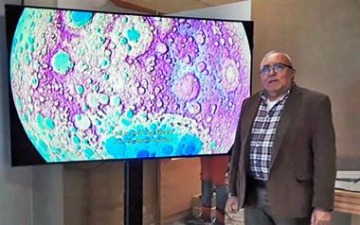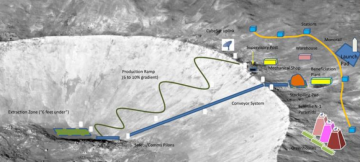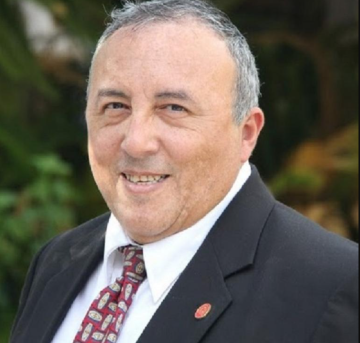April 2021
Once the first man landed on the Moon, more than a few scientists dedicated themselves to putting more sets of boot prints out there. Among those individuals is Victor Tenorio, Professor of Practice for Mining and Geological Engineering at the University of Arizona. Tenorio, with his students, is developing Luna Mine Planning (LMPL), a project that delves deep into the issues of initiating and maintaining mining operations on Earth’s moon.
“The idea is to develop the first mine planning approach for the Moon based on our experience on Earth and to try to extrapolate everything that we have learned on the Earth to the Moon,” Tenorio says.
There are quite a few variables that need to be dealt with when setting up a mine at home, and even more when working in a low gravity, extreme temperature environment. There’s also the fact that the Moon works on an entirely different time cycle than Earth—astronauts would have to acclimate to days that aren’t 24 hours long. In fact, it takes nearly a month of Earth time to get through one day-night cycle on the Moon.

Tenorio and his students are researching ways to overcome these challenges and any others that could put a halt to lunar mining once underway. For example, instead of transporting excessively heavy building materials, mining astronauts could set up a temporary shelter and then use a 3D printer to create any equipment from replacement parts to greenhouses for gardening. Best of all, there is ample printing material: The Moon’s surface is covered in rocky sediment, or regolith. Samples brought back on previous missions have shown that it’s excellent for construction.
A lot of the team’s planning for LMPL is done via simulation and is a work in progress. “Some things, like the software itself, or the technologies that we want to use are kind of sketched, but not completely developed,” Tenorio says.
Automation is the future, or is it?
The Moon isn’t exactly a place where life flourishes on its own, so it makes sense to explore the possibility of sending robots ahead to do the heavy lifting while humans stay firmly grounded. However, according to Tenorio, delegating lunar mining to an automated system might not be as appealing as it sounds on paper.
Although the technology and safety measures in mines have developed at a blinding pace in the last few years, it’s inevitable that something goes wrong. Maybe it’s a part that gets too worn or a vehicle that needs adjusting, but no system is completely flawless. If other attempts at space exploration have shown us anything, it’s that things never go as planned. And, if an issue can happen in a mine on Earth, the same things can happen on the Moon.
“Some of the things still need to be supervised by people, that’s why we don’t just want to send robots to do everything. If a machine breaks, we need to fix it,” Tenorio says. “We need to be able to do quick changes or redesigns or other things that may need human attention.”
The commute from Earth to the Moon (more than 238,000 miles) is simply too lengthy and expensive to be calling engineers back and forth for things that need an immediate fix. Communication delays between Earth and a lunar mining headquarters also make it more difficult to include self-righting solutions into the initial builds, let alone the immense time and effort it would take to design fail safes into already complicated tech.
In the end, it’s both more efficient and more profitable to send the manpower along with the machine power.
“We know it’s not necessarily a friendly place, because there’s no oxygen, but we have to get used to that. It happens in all mines. I’ve been in mines in the Andes in very remote place and it looks like it’s the end of the world,” Tenorio says. The Moon is even more desolate, but he thinks that after some psychological and technical preparation, humans should be just fine to live at the lunar mine in two-month cycles.
High risk, high reward
The question of ‘is it worth it?’ still lingers for any expedition into space, be it mining or otherwise. Tenorio himself was skeptical of a sustainable lunar mining headquarters at first. There are some rare earth minerals and metals on the Moon, but the returns of those resources alone are hardly worth the price tag of setting up an operation and habitation fit for humans.

Proposed Lunar mining operation
That’s why the discovery of water in some of the Moon’s permanently shadowed regions—areas that are never hit by sunlight, usually at the bottom of craters—was so incredibly important. The value of water goes beyond the normal uses of drinking and cleaning, especially in extreme environments. At the LMPL, it can be broken down into its component parts: “Hydrogen can be used in the future for fuel, and oxygen for breathing,” Tenorio says. “And that’s just the beginning.”
Having these resources available on location, rather than having to transport them all the way from Earth makes the idea of a permanent base much more attainable. Humans can stay there longer, resupply missions can happen less often, and the process becomes more efficient overall.
Even better, the lunar mining operation could become a sort of ‘gas station’ for other missions. Launches from the Earth could stop here to top off, and launches directly from the Moon—to Mars, perhaps, and beyond—would be much cheaper. A steady fuel supply also opens the possibility of other types of launches such as telescopes, with no fear of atmospheric interference, or even a new space station.
Allowing for interdisciplinary work to branch out of the primarily mining project is exactly what Tenorio has planned for the future of LMPL. With any luck, the project will be ready to launch in the next five years, with people living there full time within the next 15-20 years.
Tenorio and his students will be presenting their work at a few upcoming conferences and competitions, including the NASA-sponsored “Break the Ice Lunar Challenge” in June 2021.


